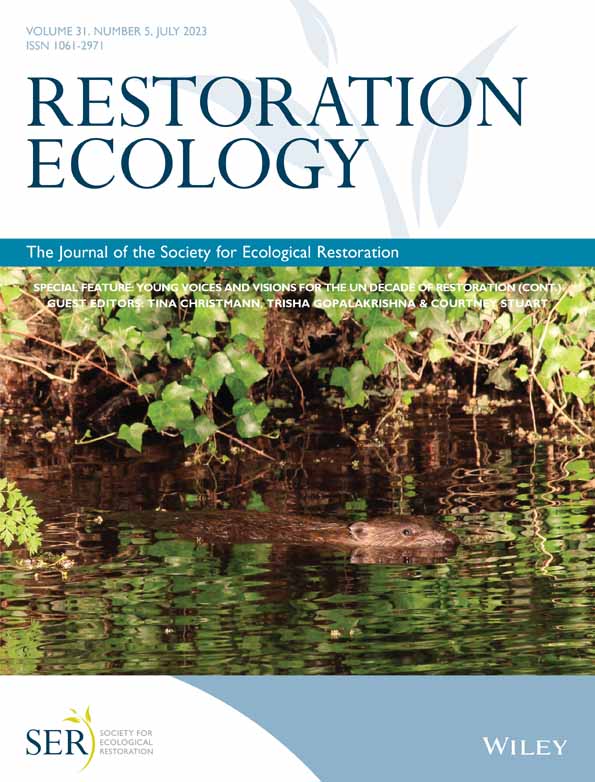Growth responses of 20 boreal forest species to oil sands non-segregating tailings: significance for reclamation
Author contributions: JJZ, RV conceived and designed the study; WQZ performed experiments, collected and analyzed data, wrote the original draft; EM advised on the data analyses and presentation of results, contributed to the inferences drawn from the results, and edited the manuscript; KF, MM edited the manuscript; all authors contributed to the manuscript writing and revisions.
Abstract
Oil sands mining in northeastern Alberta, Canada, generates tailings containing sand, silt, clay, water, and residual bitumen with hydrocarbons. The impact of tailings on revegetation is a major environmental concern and poses a significant land reclamation challenge. Oil sands companies have recently developed technologies that use thickeners in combination with carbon dioxide to produce non-segregating tailings (NST), to accelerate the consolidation of tailings while sequestering greenhouse gases. Effects of these tailings on plant re-establishment have yet to be determined. We investigated the impact of NST on biomass and physiology of 20 boreal woody plant species grown in environmentally controlled growth rooms. The seedlings were grown for 8 weeks in NST capped with boreal forest topsoil or peat-mineral soil mix or petroleum coke in 50-cm-long polyvinyl chloride pipes. We found that the biomass of balsam fir, beaked hazelnut, blueberry, green alder, Labrador tea, lowbush cranberry, paper birch, and raspberry was severely reduced by NST, while the effects on balsam poplar, Bebb's willow, chokecherry, dogwood, saskatoon, and white spruce were relatively weak. This was also the case for jack pine, which showed poor survival in NST. The negative impact of NST on plants can be largely explained by elevated sodium and decreased foliar nutrient concentrations. The impact of NST capping with petroleum coke on plant growth was non-significant. Differences among species in their survival and biomass responses to NST appeared to be partly a reflection of their natural habitats. Findings from this study can help guide revegetation oil sands reclamation strategies.
Implications for Practice
- Growth responses of boreal forest plant species to non-segregating tailings (NST), a novel oil sands tailings material, reflect species natural habitat associations.
- NST tolerant species—including balsam poplar, chokecherry, saskatoon, Bebb's willow, dogwood, and white spruce—should be given priority for revegetation of NST-affected reclamation sites.
- Alleviating foliar sodium phytotoxicity in plants grown at NST-affected areas is crucial for successful reclamation.
- Results from this study can help to predict responses of 20 boreal plant species to elevated soil salinity, high pH, and root hypoxia.
Introduction
Many forest ecosystems around the world are severely disturbed due to the exploitation of mineral and energy resources and the re-establishment of forest vegetation on these sites is a substantial challenge (Macdonald et al. 2015). In northeastern Alberta, Canada, oil sands surface mining is an ongoing operation and has disturbed approximately 900 km2 of boreal forest (Government of Alberta 2017). The operations involve complete clearing of native vegetation and stripping of surface soil. The oil sands ore is extracted in a processing facility with hot water and chemicals containing sodium hydroxides (Fung & Macyk 2000). The highly saline and alkaline tailings are then discharged into Dedicated Disposal Areas (DDA), previously referred to as tailings ponds. The Government of Alberta requires that oil sands operators remediate and reclaim the disturbed land to a self-sustaining ecosystem with equivalent land capability to that which existed prior to the disturbance (Alberta Environment 2010). Soil construction in oil sands reclamation often uses forest topsoil (TS) or peat-mineral soil mix (PMM), as a capping soil, over substrates of tailings sand or saline marine shale overburden materials (Duan et al. 2018). PMM is a mixture of humic, mesic, and fibric forms of lowland organic peat deposits and sandy mineral soils and is associated with high organic matter content and high water-holding capacity, which make it beneficial for seedling establishment (Pinno & Errington 2015). Petroleum coke, a major byproduct of the oil sands industry, has high organic content and provides another option for a soil amendment to be used in reclamation (Luna Wolter et al. 2021). Due to the migration of salts through the layers of underlying tailings sand or overburden, reconstructed soils can be associated with high salinity and high pH, which impair the survival and growth of plants used for reclamation (Renault et al. 1999; Zhang et al. 2013; Duan & Chang 2017).
Natural consolidation and settlement of conventional oil sands tailings in DDA might take several decades (Mikula et al. 1996). Recently, Canadian Natural Resources (CNRL) has developed new technologies to produce non-segregating tailings (NST) (CNRL 2022). Production of NST involves oil sands tailings consolidation through the use of cyclones that separate the coarse sand, and the addition of thickeners. The separated tailings water is discharged into the DDA. The coarse tailings sand and thickener underflow are mixed and further combined with CO2 from the capture plant. When deposited into the mining pits, NST is a homogeneous and semi-cohesive mass (CNRL 2022). Production of NST can reduce the freshwater usage for bitumen extraction by 30% and shorten the settlement time for solids (fines) of oil sands tailings ponds by 80%. In addition, it is estimated that each year 438,000 tons of CO2 is captured in the NST at Canadian Natural's Horizon Oil Sands facility (COSIA 2020). The solid part of oil sands tailings is often used as a substrate in reclamation, which is then capped with a layer of forest TS or PMM of 15 to 100 cm depth (Fung & Macyk 2000). However, the salts and chemicals in the substrate tailings can still migrate into the surface material, and the root system of some species can grow into the NST substrate. In another study, we found that the phytotoxic factors of NST water include high pH, high electric conductivity, elevated sodium and fluoride levels, and high concentration of naphthenic acids. (manuscript in preparation). However, the potential impacts of NST on the growth of plants used for reclamation are largely unknown.
In our recent study, the sodium adsorption ratio (SAR, 83) and pH (8.8) measured in NST solids were significantly higher than in forest TS (SAR 2.4; pH 5.9) or PMM (SAR 0.7; pH 5.8) (Zhang et al. 2020). NST significantly impaired growth and physiological performance of paper birch (Betula papyrifera), white spruce (Picea glauca) and green alder (Alnus viridis), with the growth inhibition effect particularly pronounced in white spruce (Zhang et al. 2020). The results also showed that placement of TS or PMM over NST could significantly benefit plant growth, possibly due to a more balanced nutrient uptake (Zhang et al. 2020). Soil electrical conductivity (EC) has been reported as a potentially important factor in determining productivity and plant community structure in some areas of the boreal forest (Purdy et al. 2005; Trites & Bayley 2009). An EC of 4 mS cm−1 can reduce plant growth by 40% in some boreal forest regions (CEMA 2006; Lilles et al. 2012). While traditional gypsum-amended composite tailings have relatively high EC (>4 mS cm−1) (Renault et al. 1999), the EC of NST solids (0.8 mS cm−1) is considerably lower than the recommended maximum soil EC (2 mS cm−1) for revegetation in oil sands reclamation areas to avoid salinity stress on plants (Alberta-Environment 2010; Zhang et al. 2020).
In Alberta, reclaimed lands are expected and required to develop into self-sustaining ecosystems (Macdonald et al. 2015); thus they should include a diversity of native species, reflective of communities found in the various site conditions found within the region. In the present study, we compared the survival, growth, and physiological performance of 20 boreal woody plant species grown in six types of growth media containing a combination of NST and/or coke, and capped with reclamation cover materials of TS and PMM. The objectives of the study were: (1) to screen plant species as to their suitability for revegetation in NST- affected reclamation sites; (2) to find relationships between species' natural habitats and their responses to NST.
Methods
Plant Material, Growth Conditions, and Growth and Physiological Measurements
Seedlings from 20 boreal forest woody plant species (Table 1) were obtained from Tree Time Services Inc. in Alberta, Canada. All seedlings were 1 year old except for jack pine and saskatoon seedlings, which were 2 years old. The seedlings were grown in Styrofoam block containers (415D 77/170 styroblocks™, Beaver Plastics, Acheson, AB, Canada) from seeds collected in the undisturbed boreal forest in the vicinity of Canadian Natural's oil sands mines in northeastern Alberta, Canada. The forest litter, fermented, humus and TS (0–50 cm below the forest floor layer) material was collected from an upland boreal forest site near Canadian Natural's Horizon mine (57°34′N and 111°75′W), about 90 km north of Fort McMurray, Alberta, Canada. Peat-mineral soil mix, coke, and NST were obtained from Canadian Natural's Horizon mine.
| Common Name | Scientific Name |
|---|---|
| Balsam fir | Abies balsamea (L.) Mill. |
| Balsam poplar | Populus balsamifera L. |
| Beaked hazelnut | Corylus cornuta Marshall |
| Beaked willow | Salix bebbiana Sarg. |
| Black spruce | Picea mariana (Mill.) Britton, Sterns, & Poggenb. |
| Blueberry | Vaccinium myrtilloides Michx. |
| Canada buffaloberry | Shepherdia canadensis (L.) Nutt. |
| Schubert chokecherry | Prunus virginiana L. |
| Green alder | Alnus viridis (Chaix) DC. |
| Jack pine | Pinus banksiana Lamb. |
| Labrador tea | Ledum groenlandicum Oeder |
| Low-bush cranberry | Viburnum edule (Michx.) Raf. |
| Paper birch | Betula papyrifera Marshall |
| Red-osier dogwood | Cornus sericea L. |
| Northline saskatoon | Amelanchier alnifolia |
| Sandbar willow | Salix exigua Nutt. |
| Tamarack | Larix laricina (Du Roi) K. Koch |
| Trembling aspen | Populus tremuloides Michx. |
| White spruce | Picea glauca (Moench) Voss |
| Wild raspberry | Rubus idaeus L. |
The study was conducted in a growth room, with 22/18°C (day/night) temperature, 65 ± 10% relative humidity, and 16-hour photoperiod at 350 μmol m−2 s−1 photosynthetic photon flux density. A simple completely randomized design was used in this study. The plants were grown in an experimental setup that we reported previously (Zhang et al. 2020). Briefly, 50-cm-long polyvinyl chloride (PVC) pipes (10 cm in diameter) were filled with one of six types of media: (A) 40 cm of forest TS, (B) 40 cm of PMM, (C) 40 cm of NST, (D) 30 cm of NST capped with 10 cm of TS, (E) 30 cm of NST capped with 10 cm of PMM, and (F) 20 cm of NST capped with 10 cm of coke and then 10 cm of TS (Fig. 1).An application of 10 cm of TS over 1 m of sand on top of overburden has been shown to result in higher species richness compared to an application of 20 cm (Mackenzie & Naeth 2010). Therefore, we chose to use 10 cm as the depth of the capping material covering the NST substrates. Choosing TS rather than peat mineral mix also tends to lead to greater native species groundcover, higher woody plant density, and a reduction in the abundance of non-native species (Dhar et al. 2018). Due to the limited space in the growth room, we used only TS to test the effects of coke as a co-capping material on the responses of plants to NST substrates. One seedling was grown in each tube and there were eight seedlings per species grown in each type of medium (n = 8) for 8 weeks. The plants were watered every other day and fertilized weekly with 50% modified Hoagland's solution.
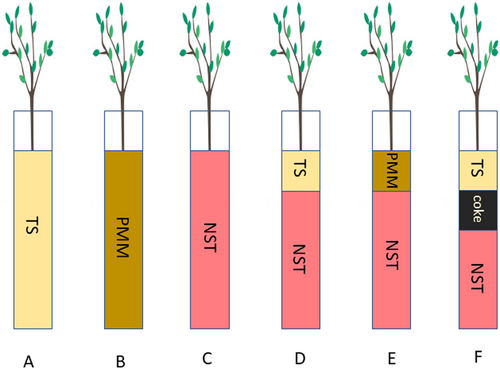
All plants were harvested at the end of 8 weeks of treatment. The mortality rate (n = 8 seedlings per species per treatment), shoot dry biomass (SDB) (n = 8), root dry biomass (RDB) (n = 8), total dry biomass (TDB) (n = 8), SDB to RDB ratio (S:R) (n = 8), net photosynthesis rate (Pn) (n = 6), transpiration rate (E) (n = 6), leaf chlorophyll concentration (CHL) (n = 6), and leaf concentrations of Na, Mg, P, K, Ca, Fe, Mn, Cu, and Zn (n = 6) were measured. Briefly, shoot and root samples of all seedlings were oven dried at 70°C for 72 hours to determine dry biomass and SDB to RDB ratio; while gas exchange (Pn and E) was measured on the uppermost fully expanded leaves of six randomly selected seedlings between 9:00 and 12:00 with a LI-6400XT portable photosynthesis system (LI-COR, Lincoln, NE, USA). The flow rate was set at 200 μmol s−1; reference CO2 concentration was 400 μmol mol−1; the leaf chamber temperature was 20°C, and light intensity was 400 μmol m−2 s−1. Leaf samples collected from these six seedlings were also used for the chlorophyll and elemental analyses. Fresh leaf samples were collected in a paper bag and dried in a lyophilizer (Freeze Dry Lyph-Lock, Labconco, KS, USA) for 72 hours and then pulverized into powders by a Thomas Wiley Mini-Mill (Thomas Scientific, NJ, USA). Chlorophyll was extracted from 10 mg dry leaf powder samples with 8 mL dimethyl sulfoxide at 65°C for 22 hours and the concentrations measured spectrophotometrically at the 648 and 665 nm wavelengths. For the elemental concentration analysis, 0.2 g leaf samples were digested in 10 mL 70% HNO3 at 185°C for 10 minutes in a microwave digestion oven (Mars 5 Microwave Accelerated Reaction System, CEM), diluted into 40 mL with Milli-Q water, and analyzed using a Thermo Scientific Icap6300 inductively coupled plasma-optical emission spectrometer.
Data Analyses
A plant was regarded as dead either when it lost all leaves or all the leaves were completely dry. Mortality rate was calculated as the number of dead plants divided by the total number of replicates (eight) and expressed as a percentage. To assess the effect of substrate on growth (biomass) we first standardized the TDB of seedlings in each treatment as a percentage of the mean TDB of seedlings grown in TS alone. This aided presentation of results among species with large differences in biomass. Then, one-way analysis of variance was carried out to compare mean TDB among the six treatments, for each species separately. The Student–Newman–Keuls test was used for pairwise post-hoc comparisons among treatments (α = 0.05). To organize the species into groups based on their biomass and physiological responses to NST we conduced cluster analyses. The dataset used for the cluster analyses consisted of growth, physiological and foliar elemental response values of plants grown in NST alone (with no capping). As the blueberry seedlings grown in the NST alone treatment had a 100% mortality rate, they were not included. The data were first standardized to a mean of zero and a variance of one. Ward's linkage was selected as the optimum clustering method and a matrix of Euclidean Distances was calculated. Silhouette Plots were used to select the optimal number of clusters (Borcard et al. 2011). One cluster analysis was completed using data for all biomass and physiology parameters (SDB, RDB and TDB, shoot: root ratio, leaf chlorophyll concentration, and net photosynthesis and transpiration rates), and a separate cluster analysis was conducted using the foliar ion concentrations (Na, Mg, P, K, Ca, Fe, Mn, Cu, and Zn). To further examine the impact of NST on the various response variables, and further verify the species groups determined by cluster analysis, a principal component analysis (PCA) was performed on the same datasets of biomass and physiology parameters and leaf element concentrations. All analyses were conducted in R version 4.0.0 using the vegan packages (R Core Team 2020). The results for all response parameters are in Tables S1–S17.
Results
Mortality and Biomass of Plants
For plants grown in TS or PMM only one or no seedlings died, therefore, the mortality rates of seedlings grown in these two treatments are not presented. Jack pine, raspberry, balsam fir, lowbush cranberry, and blueberry had a high mortality rate (>60%) when grown in just NST (Table 2; Fig. 2). Balsam poplar, buffaloberry, Bebb's willow, aspen, sandbar willow, dogwood, beaked hazelnut and Labrador tea had a relatively low mortality rate in all substrate treatments (<20%; Fig. 2). Chokecherry, saskatoon, black spruce, tamarack, white spruce, green alder, and paper birch had intermediate levels of mortality (0–60%, depending on the substrate). Capping resulted in lower mortality of jack pine, black spruce, raspberry, beaked hazelnut, balsam fir, lowbush cranberry, green alder, and blueberry, as compared to growth in NST alone (Table 2; Fig. 2). In eight out of the 20 species, plant mortality was lower for the substrate that included coke as a capping material, as compared to other capping materials (chokecherry, black spruce, white spruce, raspberry, balsam fir, lowbush cranberry, green alder, blueberry) (Fig. 2). However, for saskatoon and paper birch, the treatment that included coke in the capping material resulted in the highest mortality (Fig. 2).
| Mortalitya | Capping Reduced Mortality?b | Effect on Biomassc | Capping Improved Growth?b | Physiol and Growth Clusterd | PCA Associationse | Foliar Clusterf | PCA Associationsg | |
|---|---|---|---|---|---|---|---|---|
| Balsam poplar | − | − | − | − | 1 | Higher photosynthesis (Pn), transpiration (E), chlorophyll (CHL), total dry biomass (TDB) and shoot dry biomass (SDB) | 1 | Lower foliar P, Mn, Fe |
| Chokecherry | − | − | − | − | 1 | 1 | ||
| Saskatoon | − | − | − | − | 1 | 3 | Average foliar P, Mn, Fe | |
| Buffaloberry | − | − | + | − | 1 | 2 | Higher foliar P, Mn, Fe | |
| Bebb's willow | − | − | − | − | 1 | 1 | Lower foliar P, Mn, and Fe | |
| Aspen | − | − | + | + (TS + Coke) | 1 | 3 | Average foliar P, Mn, Fe | |
| Sandbar willow | − | − | + | − | 1 | 3 | ||
| Jack pine | * | * (PMM) | − | − | 2 | Lower Pn, E, CHL, TDB, SDB, shoot-to-root (S:R) | 2 | Higher foliar P, Mn, Fe |
| Black spruce | + | * (TS + Ck) | + | − | 3 | Higher S:R, lower RDB | 1 | Lower foliar P, Mn, and Fe |
| Tamarack | + | − | − | − | 3 | 1 | ||
| Dogwood | − | − | − | * | 3 | 1 | ||
| White spruce | − | − | − | − | 3 | 1 | ||
| Raspberry | * | * (PMM), + (TS + Ck) | * | * | 4 | Lower Pn, E, CHL, TDB, SDB | 1 | |
| Beaked hazelnut | − | + (TS, PMM) | * | * | 4 | 3 | Average foliar P, Mn, Fe | |
| Balsam fir | * | * (all) | − | − | 4 | 2 | Higher foliar P, Mn, Fe | |
| Lowbush cranberry | * | * (all) | − | − | 4 | 3 | Average foliar P, Mn, Fe | |
| Green alder | + | + (all) | * | * | 4 | 3 | ||
| Labrador tea | − | − | * | * | 4 | 2 | Higher foliar P, Mn, Fe | |
| Paper birch | − | − | * | − | 4 | 3 | Average foliar P, Mn, Fe | |
| Blueberry | * | * (all) | *? | * (PMM) | N/A | not included as all died | N/A | Not included as all died |
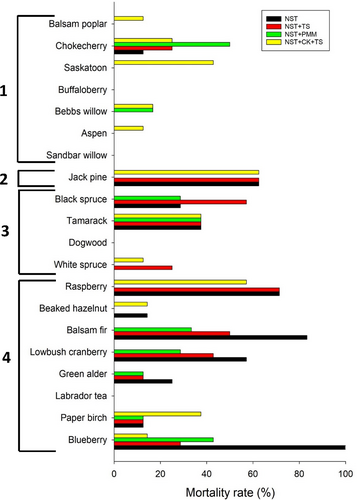
For balsam poplar, dogwood, Labrador tea, and paper birch, the plants that were grown in PMM (alone) had greater biomass compared to those grown in TS (alone), while for the other species there was no significant difference between these two (Fig. 3). Growth in NST-containing media, as compared to growth in TS or PMM alone, resulted in lower biomass for several species; this negative impact was particularly strong for: raspberry (NST, NST + TS), beaked hazelnut, green alder (NST), Labrador tea (NST), and paper birch. Effects were more moderate for: buffaloberry, aspen, sandbar willow, and black spruce (Table 2; Fig. 3). For some species (raspberry, beaked hazelnut, green alder, paper birch), some of the NST treatments resulted in dry biomass that was only 30–50% of the dry biomass of seedlings grown in TS or PMM alone (Fig. 3). As was observed for mortality, capping treatments somewhat alleviated the negative effects of growth in NST on biomass; the dry biomass was higher in at least some of the treatments with NST plus capping than in NST alone for: aspen, dogwood, raspberry, beaked hazelnut, green alder, Labrador tea (Fig. 3). There were no differences between PMM and TS when used as capping materials in terms of biomass (TDB) for any species (Fig. 3). Aspen and raspberry had higher dry biomass in NST capped with coke and TS than in TS alone (Fig. 3). There were generally no differences in dry biomass between seedlings grown in TS vs. peat mineral mix alone except for balsam poplar, dogwood, Labrador tea, and paper birch, all of which had greater biomass when grown in peat mineral mix than in TS alone. For chokecherry, saskatoon, Bebb's willow, jack pine, tamarack, white spruce, balsam fir, lowbush cranberry, there were no significant differences in TDB among the treatments (Fig. 3). This was also the case for blueberry, bearing in mind there were no dry biomass data for blueberry grown in NST because all the seedlings died.
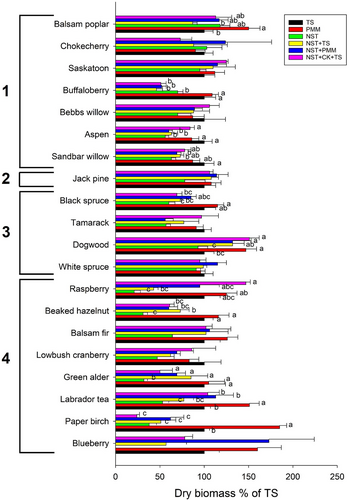
In addition to the known negative properties of NST (high pH and salinity) we also noted during this study that plants grown in NST-containing substrates were often under waterlogging stress, as water often accumulated in the PVC pipes that contained NST due to the low permeability of the tailings.
Cluster Analysis and PCA Based on Biomass, Physiological, and Elemental Responses
The cluster analysis of the 19 species (excluding blueberry), based on biomass and physiology responses, resulted in four groups: (1) balsam poplar, chokecherry, saskatoon, buffaloberry, Bebb's willow, aspen, and sandbar willow; (2) jack pine; (3) black spruce, tamarack, dogwood, and white spruce; (4) raspberry, beaked hazelnut, balsam fir, lowbush cranberry, green alder, Laborador tea, and paper birch (Fig. 4A). Analysis based on leaf elemental concentrations resulted in three groups: (1) white spruce, tamarack, dogwood, balsam fir, chokecherry, Bebb's willow, black spruce, and raspberry; (2) jack pine, Labrador tea, balsam fir, and buffloberry; (3) aspen, sandbar willow, saskatoon, paper birch, beaked hazelnut, green alder, and lowbush cranberry (Fig. 4B).
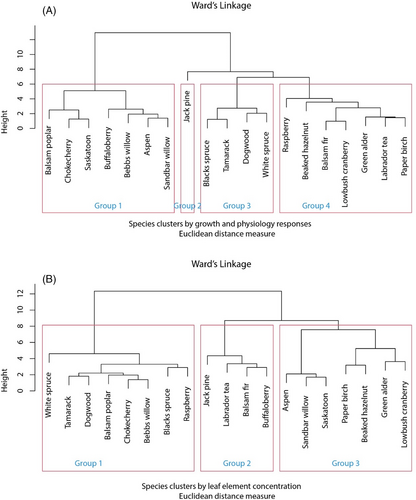
****In the PCA of biomass and physiological responses, PC1 and PC2 accounted for 49% and 19% of the total variation, respectively (Fig. 5A). Relative Pn, E, CHL, TDB, and SDB were positively correlated with each other and were negatively associated with the first axis (PC1). In contrast, the second axis (PC2) was mostly defined by RDB and S:R, which were negatively correlated with one another, being positively and negatively associated, respectively, with PC2 (Fig. 5A). The species in Cluster 1 (Fig. 4A) loaded to the low end of PC1, thus being associated with higher relative Pn, E, CHL, TDB and SDB (Fig. 5A). When grown in NST, these species had low mortality (Fig. 2) and their biomass was not strongly reduced (Table 2; Fig. 3). Jack pine, the sole species in Cluster 2, loaded to the higher end of PC1 and 2, being associated with lower relative Pn, E, CHL, TDB SDB, and S:R but higher RDB. It had very high mortality when grown in NST but for surviving seedlings, biomass was unaffected by NST. The species in Cluster 3 (Fig. 4A) loaded to the negative side of PC2, being associated with higher relative S:R and lower RDB (Fig. 5A). They had medium to low mortality when grown in NST and showed minimal effects of NST on biomass (Figs. 2 & 3). Finally, the species in group 4 loaded to the positive side of PC1 being associated with lower relative Pn, E, CHL, TDB, and SDB; for these species, growth in NST resulted in variable mortality but relatively strong negative effects on biomass (Table 2; Fig. 3).
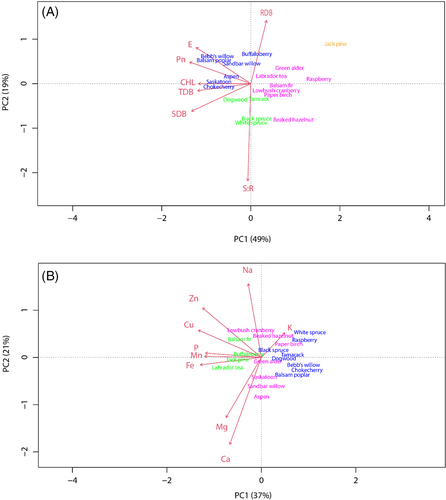
In the PCA of foliar elemental responses, PC1 and PC2 contributed to 37% and 21% of the variation, respectively (Fig. 5B). Three elements (Fe, Mn, P) were positively correlated with one another and negatively related to PC1; foliar K was negatively correlated with Mg and Ca and thus positively related to PC1. PC2 was negatively related to Ca, Mg, and positively related to Na concentrations. (Fig. 5B). The species in Cluster 1 (from the foliar data; Fig. 4B) loaded to the higher end of PC1 being associated with lower foliar concentrations of P, Mn, and Fe. When grown in NST these species had generally low mortality and experienced minimal effects on biomass (except raspberry, which had high mortality and strong negative effects on biomass). The species in Cluster 2 (Fig. 4B) loaded to the negative side of PC1, being associated with higher foliar P, Mn, and Fe concentrations. These species showed variable responses to NST: buffaloberry and Labrador tea had low mortality and relatively strong negative effects on biomass, whereas jack pine and balsam fir had high mortality but no effects on biomass (Table 2; Figs. 2 & 3). The species in Cluster 3 (Fig. 4B) were centrally located on PC1 with spread to both the positive and negative side on PC2; this indicates they had average levels of foliar P, Mn and Fe but higher or lower levels of Na, Ca, and Mg. All these species, except lowbush cranberry, showed low mortality in NST but varied in the effects of NST on biomass: two species showed no effects (saskatoon, lowbush cranberry) and two had moderately negative effects (sandbar willow, aspen); all the others showed strong negative effects on biomass (Figs. 2 & 3).
Discussion
The effects of NST on survival, biomass, and physiological performance varied among the 20 studied boreal forest species, as did the efficacy of capping to alleviate negative effects. As such, the results can provide guidance for selecting species and capping prescriptions to facilitate successful revegetation with a variety of native boreal forest species when reclaiming oil sands reclamation sites using NST.
From the cluster analysis of biomass and physiological responses, four different generalized responses to growth in NST were observed: (1) species that were not much affected by NST (group 1: balsam poplar, chokecherry, saskatoon, buffaloberry, Bebb's willow, aspen, sandbar willow); (2) species with high mortality when grown in NST, but for which surviving seedlings performed relatively well, potentially due to their higher root biomass (RDB) (group 2: jack pine); (3) species with moderate to low mortality, but for which surviving seedlings were not much affected by NST (group 3: black spruce, tamarack, dogwood, and white spruce); and (4) species for which NST had relatively stronger negative effects on growth (biomass) (group 4: raspberry, beaked hazelnut, balsam fir, lowbush cranberry, green alder, Labrador tea, paper birch). From the cluster analyses of foliar nutrients, three responses were observed: (1) species that managed to survive and grow relatively well, despite negative effects of growth in NST on foliar nutrition (group 1: white spruce, tamarack, dogwood, balsam poplar, chokecherry, Bebb's willow, black spruce, raspberry); (2) species that managed to maintain their foliar nutrition when grown in NST, but at a cost (high mortality but surviving individuals grew okay, or survived but with negative impacts on growth) (group 2: jack pine, Labrador tea, balsam fir, buffaloberry); and (3) species that managed to maintain average foliar nutrition and survive reasonably well when grown in NST, but with negative impacts on biomass (group 3: aspen, sandbar willow, saskatoon, paper birch, beaked hazelnut, green alder, lowbush cranberry).
In oil sands reclamation soils, composed of capping materials and substrates, high pH, salinity, and nutrient deficiencies, are the most important factors affecting the success of revegetation (Zhang et al. 2013; Ojekanmi & Chang 2014; Welegedara et al. 2020). Rooting biomass is, therefore, likely important for explaining the different plant responses to tailings stress. The PCA on biomass and physiological responses showed the strong influence of root dry biomass and the shoot to root dry biomass ratio, in differentiating among the groups. Among the studied species, three are shallow rooted: paper birch has few roots deeper than 60 cm below the soil surface (FEIS 2020a); green alder has a shallow fibrous root system (FEIS 2020b); and beaked hazelnut has more than 90% of its roots in the top 20 cm of soil (FEIS 2020c). All three of these species showed relatively stronger negative impacts of growth in NST. The impact of NST capping with petroleum coke on plant growth was not large; aspen and raspberry were the only species that showed slightly higher dry biomass when grown in NST that was capped with coke and TS, as compared to growth in NST that was capped with only TS. The high amounts of organic carbon in petroleum coke were reported to have potential benefit to plant growth through the improved physical and chemical properties of soil (Small 2011); however, the effects varied among plant species.
In this study, balsam fir and blueberry had particularly high mortality when grown in NST. This could be attributed to the alkalinity of NST (pH 8.8), since both these species are naturally found on more acidic soils (Frank Robert 1990). We previously reported that the growth of aspen, paper birch, green alder, dogwood, jack pine, and tamarack was significantly impaired by high root zone pH in hydroponic studies (Zhang et al. 2013; Zhang et al. 2015; Zhang & Zwiazek 2016a; Zhang & Zwiazek 2016b). In the present study, only three of these (aspen, paper birch, green alder) displayed negative effects of NST on biomass. This could suggest that dogwood, jack pine and tamarack might have better tolerance to high pH conditions when grown in a solid substrate compared with the hydroponic culture. We previously reported that the survival and growth of 1-year-old jack pine seedlings were strongly impaired by high root zone pH (Zhang et al. 2015), though it has also been reported that jack pine can grow in calcareous soils if associated with mycorrhizae (Rudolph & Laidly 1990). The 2-year-old jack pine seedlings we used showed relatively high mortality when grown in NST containing substrates, but the growth of the surviving seedlings was not significantly impaired.
Waterlogging stress, due to the low porosity of NST, may partially explain the negative impacts on survival and/or growth in NST of species. Jack pine, blueberry, and buffaloberry naturally grow on drier, sites with sandy soils. Aspen, raspberry, balsam fir, beaked hazelnut, lowbush cranberry, and green alder naturally grow on mesic, upland, sites with mineral soil. Surprisingly, chokecherry and saskatoon were minimally affected by NST, although they naturally grow on these same site types. Raspberry is known to be intolerant of wet soil, as that can cause root rot (Missouri Botanical Garden 2020). Labrador tea, for which growth was negatively affected by NST, can grow on sites with a wide range of soil moisture conditions. In contrast, the weak or absent negative effects of NST on some species can be explained by their natural adaptations. Bebb's willow and sandbar willow are typically found on moister sites (riverbanks, lakesides, swamps, marshes, bogs) and are very tolerant of flooding; balsam poplar is flood tolerant and can form adventitious roots a few days after flooding (Krasny et al. 1988). Dogwood is a very adaptable plant, tolerating both dry conditions and even some standing water and is not specific to any soil type or pH (FEIS 2020d). Black spruce and tamarack, which showed moderately negative effects of growth in NST, naturally grow on wet sites—but ones that are acidic.
The high SAR of NST was expected to influence foliar element concentration and this was evident in the PCA, as the Ca and Mg vectors shared a similar trajectory, opposite to that of Na, which showed elevated foliar concentrations in almost all studied species. Foliar concentrations of Zn, Cu, P, Mn, and Fe were correlated with one another and indeed, deficiencies in these nutrients are common symptoms of plants growing in high pH soils as well as oil sands reclamation areas (George et al. 2012; Zhang et al. 2013). Deficiencies in foliar Fe and Mn are often associated with leaf chlorosis and reduced photosynthesis rates (Mengel 1994; George et al. 2012). However, only raspberry showed both low levels of these foliar nutrients, and low leaf chlorophyll and photosynthesis rates.
This study demonstrated that negative effects of growth in NST on survival and growth varied among boreal woody species; to some extent these differences reflected species' natural habitats. Overall, the species expected to perform best on reclamation sites with NST are: balsam poplar, chokecherry, saskatoon, Bebb's willow, dogwood, and white spruce. Species showing stronger negative effects of growth in NST on survival or growth include: lowbush cranberry, raspberry, jack pine, blueberry, balsam fir, beaked hazelnut, green alder, and Labrador tea. Capping with TS, PMM, or TS + coke can help alleviate the negative effects of NST for: dogwood, beaked hazelnut, green alder, and Labrador tea. Some capping materials could effectively ameliorate negative effects of growth on NST for aspen (TS + coke), and raspberry (PMM PMM, TS + coke). Inclusion of petroleum coke, a by-product of the oil sands industry, in the capping material improved survival—perhaps because it has high organic content and could alleviate the water-logging effects associated with the fine texture of NST. But, other than for aspen and raspberry, it was not more effective than other capping materials in terms of alleviating negative effects of growth in NST on biomass. Measures for alleviating phytotoxicity due to high sodium levels in NST-amended reclamation materials need to be further investigated. The findings of this study are meaningful to help guide revegetation both in NST and traditional tailings affected oil sands reclamation areas.
Acknowledgments
The authors thank Ira Sherr for his work at the initial stage of this project. The authors also thank Xuehui Sun and Yexin Han for their assistance on the harvesting of the plants and sample preparations. This project is financially supported by Canadian Natural Resources Limited (CNRL), Canada's Oil Sands Innovation Alliance (COSIA), and the Natural Sciences and Engineering Research Council of Canada (NSERC).



